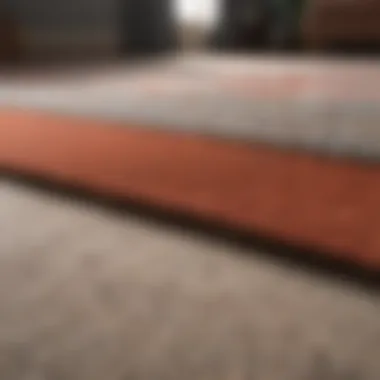Understanding Carpet Removal Costs: A Complete Guide


Intro
Removing carpet can be a significant decision for any homeowner or renter. This task often goes beyond simply lifting the flooring; it usually involves a range of considerations that greatly affect the end cost. Understanding these costs can help in making an informed choice that aligns with financial plans while achieving the desired aesthetic outcome.
In this article, we will delve into the various factors influencing carpet removal costs. Advantages of different removal methods will be explored, from professional services to DIY approaches. Each method has its own set of costs and potential challenges. We will also provide valuable tips to minimize expenses and avoid common pitfalls, ensuring a smoother process for anyone considering this project.
The landscape of flooring options is ever-evolving, and so is the demand for carpet removal. Interior designers, homeowners, and even tenants are increasingly interested in switching to more modern or sustainable flooring solutions. As we progress, the following sections will serve as a guide to navigate the intricacies of carpet removal, illuminating factors influencing pricing, services available, and prudent financial decisions.
Prologue to Carpet Removal Costs
Understanding the costs associated with carpet removal is crucial for any homeowner or renter contemplating a flooring change. Whether it's to refresh an outdated appearance, address damage, or prepare for new flooring, knowing the financial implications helps in planning effectively. Making informed decisions about carpet removal can prevent unnecessary expenses and disruptions.
Carpet removal may seem straightforward at first, but various elements influence the costs involved. Factors such as material type, room size, removal method, and labor costs play significant roles in shaping the overall budget. Consequently, familiarizing oneself with these aspects not only streamlines the process but also aids in avoiding hidden fees or unexpected expenses.
Additionally, this understanding prepares you for the decisions to be made afterwards, including the choice of new flooring. As a result, this section sets the stage for exploring the numerous factors that dictate carpet removal costs, highlighting both the importance of careful consideration and the potential for cost savings.
Overview of Cost Factors
Understanding the cost factors associated with carpet removal is essential for homeowners. Before committing to a removal project, it is crucial to recognize what influences total expenses. Knowledge of these elements empowers individuals to make informed decisions, allowing for budgeting that reflects true costs.
Various factors come into play when estimating the price of carpet removal. Each factor has its own significance and can greatly affect the final bill. For instance, the type of material being removed, the size of the room, and the methods used are foundational elements. Furthermore, labor costs can vary widely depending on local rates and the expertise of the labor. Evaluating each of these factors helps homeowners assess their options effectively and reduce unnecessary expenditures.
Material Type
The type of material in place can influence not only the removal cost but also the complexity of the process. Different types of carpets, such as plush, Berber, or tiles, may require different techniques and tools for removal. More complex materials can increase costs.
Room Size
The size of the area needing carpet removal directly correlates to the time and resources required to complete the task. Larger rooms naturally lead to higher costs. Understanding room dimensions allows for accurate budgeting.
Removal Method
Each removal method has its implications for cost and efficiency.
DIY Removal
Conducting a DIY removal can save money. The key characteristic here is the potential for significant savings on labor costs. Homeowners can tackle the project themselves, significantly reducing the financial burden. However, DIY removal might lack professional expertise, which could result in complications or damage to the flooring beneath. This approach appeals to those wanting hands-on experience and cost savings, provided they understand the risks involved.
Professional Services
Hiring professionals guarantees a smooth removal process. The key aspect is efficiency, as professionals have the necessary skills and tools. Their expertise can minimize risks, ensuring the subfloor remains intact and ready for new flooring. Though the cost is higher than DIY, the assurance of quality work is attractive for many homeowners.
Labor Costs
Labor costs can differ significantly based on various conditions. Local market rates and the level of expertise required play pivotal roles here. Understanding the labor market in your area can provide clarity. Accurate estimates will contain a breakdown of labor charges. This transparency aids in assessing whether to pursue DIY or engage professionals.
In summary, grasping these cost factors leads to better strategic planning. This understanding not only prevents financial surprises, but also ensures you are prepared for the entire process of carpet removal.
Estimated Cost Ranges


Understanding the estimated cost ranges is vital for anyone planning to remove carpet. It provides a framework for budgeting, allowing homeowners to prepare for direct costs while also considering ancillary expenses. Knowing these estimated ranges alleviates uncertainties and allows for better decision-making. This section outlines average costs associated with both DIY removals and professional services, and it also highlights potential extra fees that could impact total spending.
Average Costs for DIY Removal
For those considering a DIY approach, it's essential to weigh both material costs and the time required. Generally, the average cost for DIY carpet removal can range from $0.50 to $2.00 per square foot. This pricing typically includes the cost of tools and materials such as:
- Carpet removal tools (like a utility knife or pry bar)
- Flooring disposal bags
- Safety gear (gloves, masks)
While DIY can save on labor, it’s important to recognize that this route demands significant physical effort and skill. Expenses can escalate if tools are rented or purchased. Additionally, if any complications arise during removal, costs may rise further.
Average Costs for Professional Services
Hiring professionals generally incurs higher costs than a DIY approach. The average expense for professional carpet removal ranges between $2.00 and $6.00 per square foot. This price often includes:
- Labor costs
- Tools and equipment used for removal
- Waste disposal fees
Professional services come with the assurance that the job will be executed efficiently and safely. Splitting costs can occasionally occur in larger projects, making it beneficial for some homeowners.
Additional Fees to Consider
Beyond basic costs, there are additional fees that can emerge during the carpet removal process. Here are some elements worth considering:
Disposal Fees
Disposal fees represent an often-overlooked cost. When removing carpet, waste must be managed appropriately. Many disposal services charge between $50 and $150 to remove old carpet. This fee is significant because it ensures that discarded materials are processed sustainably. Not addressing this fee may present legal risks in some areas, emphasizing why calculating it is crucial for overall budgeting.
Floor Repair Costs
Once the carpet is removed, inspecting the subfloor is important. Floor repair costs can vary widely but often range from $100 to $500. The necessity of repairs depends on the condition of the subfloor. Any damage caused by moisture or inadequate installation may reveal the need for extensive work, making it a prominent factor in total remodel costs.
Installation Costs for New Flooring
After removing old carpet, homeowners often consider new flooring. Installation costs can differ significantly based on the chosen material. Prices can range from $1.00 up to $5.00 per square foot for installation, which adds another dimension to the total expenditure. It is essential to choose the right flooring that aligns with budget and lifestyle needs, making this consideration critical when planning a renovation.
Key Takeaway: Keeping track of potential costs during carpet removal, including disposal fees, floor repairs, and new installation, ensures that budgeting remains realistic and practical. Being informed protects against unexpected financial stress.
Comparing DIY and Professional Services
When considering carpet removal, one of the most critical decisions is whether to undertake the project yourself or hire a professional. Each approach has its distinct benefits and drawbacks, and understanding these can help homeowners and renters make an informed choice that aligns with their specific needs and budget.
Pros and Cons of DIY Removal
Opting for DIY carpet removal can seem appealing for several reasons.
Pros:
- Cost Savings: One of the most significant advantages is the potential to save money on labor costs. If you are handy and willing to put in the time, you will only need to cover the costs of materials and disposal.
- Control Over the Process: Managing the entire removal process allows you to work at your pace. This flexibility can be advantageous, particularly if you have a busy schedule.
- Sense of Accomplishment: Successfully completing a home project can give a great feeling of satisfaction. This can be particularly meaningful if you take pride in your home.
Cons:


- Time-Consuming: DIY removals often take more time than anticipated. It may require hours or even days to complete, especially if you are unfamiliar with the process.
- Potential for Mistakes: Lack of experience can lead to unintended mistakes, which may end up costing more time and money. Improper removal can also damage the subfloor, requiring additional repairs.
- Limited Tools: You may not have access to commercial-grade tools needed for the job. Without the right equipment, it can be challenging to do a thorough job.
Pros and Cons of Hiring Professionals
Hiring professionals for carpet removal has its own set of considerations.
Pros:
- Expertise and Efficiency: Professionals know the best practices for timely and effective carpet removal. Their experience can prevent common pitfalls associated with DIY projects.
- Specialized Equipment: They use advanced tools and techniques that allow for a more efficient process. This can save time and reduce wear and tear on the property.
- Level of Safety: Professionals are trained to follow safety protocols during removal. This reduces the risk of injury, especially when dealing with heavier carpets or underlayments.
Cons:
- Higher Costs: Professional services come with labor costs. Homeowners should consider whether the added expense fits within their budget.
- Less Control: Hiring outsiders means relinquishing control over how and when the work is completed. This may be a concern for some homeowners who prefer to supervise every detail.
- Finding the Right Service: It may take time to research and find a reliable carpet removal service. Not all providers are equal, and reading reviews can be essential before making a choice.
"Understanding the pros and cons of each option is essential for making an informed decision regarding carpet removal."
Ultimately, the right approach will depend on one's budget, time availability, and personal comfort with home improvement projects.
Finding the Right Service Provider
Finding a reliable service provider for carpet removal is crucial. The right choice can help ensure that the job is done efficiently and at a reasonable cost. Homeowners need to consider a few important elements when selecting a service provider.
First, experience and expertise should be a priority. Providers with years in the business often have the knowledge to handle various types of carpets and removal methods. They can address unexpected issues that arise during removal. Additionally, check online reviews and testimonials. They offer insight into previous customers’ experiences. Good reviews often indicate a trustworthy service.
Second, ensure the service provider is properly licensed and insured. This is a safeguard for both homeowners and workers. If any damage occurs during removal, insurance can cover repairs. Without proper coverage, homeowners bear the financial burden for accidents.
Lastly, consider the communication style of the provider. They should be responsive and clear about costs and timelines. Good communication lays the foundation for a successful project.
Researching Local Options
When it comes to researching local options for carpet removal, there are several strategies. Start by asking for recommendations from friends, family, or neighbors. Personal experiences often lead to trustworthy leads. You can also visit platforms like Reddit or Facebook to read about local services.
It is essential to get quotes from multiple providers. This not only helps understand the average market rate but also provides insight into the range of services. Compare these quotes carefully to see what each provider offers in terms of services and pricing.
Additionally, utilize search engines to find local businesses that specialize in carpet removal. Use keywords like "carpet removal services near me" for better search results. Check their websites for portfolios, rates, and customer feedback.
Understanding Quotes and Estimates
Understanding quotes and estimates is an integral part of hiring a carpet removal service. When you receive a quote, examine it closely. Look for any potential hidden costs. Be cautious of lowball estimates; they can signify poor quality work or additional fees later.
A comprehensive quote should detail everything, including labor, materials, and disposal fees. Inquire how they calculate their estimates. Transparent providers often have set processes and can explain their pricing clearly.
Before signing any contracts, ask for clarification on terms and conditions. Ensure you are aware of the payment schedule and any cancellation policies. The aim is to enter into a clear agreement that protects both parties.
Being well-informed about quotes and estimates can save homeowners from unexpected costs and ensure a smoother removal process.
Preparing for Carpet Removal
Preparing for carpet removal is a crucial step for homeowners and renters alike. Understanding how to approach this task can significantly streamline the process and minimize potential complications.


Before any physical work begins, it is essential to consider the layout of the room and the items within it. Preparing adequately ensures a smoother removal process. This means more than just rolling up the carpet; it involves a strategic plan to navigate obstacles and space constraints efficiently.
Being organized at this stage helps in not only saving time but also reduces the chances of damage to your belongings. It is advisable to take inventory of the room. Creating a list of which items need to be moved or adjusted can prevent forgetting vital pieces. Once your space is prepared, the actual removal can be approached with clarity and purpose.
Clearing the Space
When it comes to clearing the space, a methodical approach pays off. Begin by removing all furniture and personal items from the room. This could include sofas, tables, and decorative elements. Understanding that this step requires physical effort will help in planning your removal.
Here are some key tips for clearing the space:
- Move heavier items first: Prioritize larger furniture, as these can be more time-consuming to shift.
- Utilize storage options: If possible, use a garage or storage unit temporarily for your furniture. A clear area makes accessing the carpet much easier.
- Consider safety: Keep pathways clear. This can help prevent accidents while moving heavy items.
Taking time to clear the space properly can influence the success of carpet removal directly.
Safety Precautions
Before diving into the actual removal of carpet, safety precautions must not be overlooked. The process may involve sharp tools, heavy items, or dust and debris that can be hazardous.
Here are some safety measures to keep in mind:
- Wear protective gear: A pair of gloves and a dust mask can reduce risks associated with potential cuts and dust inhalation.
- Check for nails or staples: In many cases, carpets are held in place with nails or staples. Identify these and remove them carefully to avoid injury.
- Discuss with others: If you’re working with friends or family, communicate about movements and tasks. This helps coordinate actions safely.
- Have a first-aid kit handy: In case of any minor injuries, it's wise to have basic first aid materials close by.
Safety should be a priority in every home improvement project. A little preparation goes a long way in ensuring that you complete the carpet removal without any unfortunate incidents.
Post-Removal Considerations
After the physical task of removing carpet, homeowners often overlook the subsequent steps that are equally crucial to ensure a smooth transition. Post-removal considerations not only address immediate structural issues but also aid in planning for future flooring selections. Checking these aspects can prevent additional costs and complications later.
Inspecting the Subfloor
Once the carpet is gone, inspecting the subfloor becomes a key priority. This area is foundational and merits attention since it directly influences the integrity of new flooring. Examine the condition of the subfloor for damages, moisture issues, and squeaks.
- Signs of Damage: Look for cracks, warping, or soft spots. Damaged subflooring can compromise new flooring installation.
- Moisture Assessment: Check for moisture with a moisture meter. Areas that are excessively damp may require remediation before laying new flooring.
- Squeaking and Movement: Walk across the surface to identify any irregular noises. Such issues may indicate loose boards that need tightening before new installation.
Addressing these concerns ensures that the new flooring will be both aesthetic and durable. Failure to do so can lead to costly repairs down the line.
Deciding on New Flooring
Selecting new flooring is an opportunity to reimagine your space. The removal of the previous carpet allows for various choices, depending on your style, budget, and practical considerations. Detailing aspects of this choice can greatly enhance the final space.
- Material Options: Common choices include hardwood, laminate, vinyl, or tile. Each offers distinct benefits and challenges. Consider the room's function—high foot traffic areas may require more durable flooring.
- Aesthetic Preferences: Think about the overall decorative style of your home. The new flooring should complement existing design themes. If you favor modern minimalism, sleek materials will align well.
- Budget Constraints: Flooring costs vary widely. List potential materials with their respective costs to make an informed decision aligned with your financial parameters.
- Installation Method: Will you hire professionals or tackle a DIY project? Professional installation could provide better long-term results, but is also an additional cost.
"Choosing the proper flooring after carpet removal can significantly enhance overall home value and aesthetic appeal."
Understanding these post-removal aspects ensures a strategic approach to home improvement. Making informed decisions not only reflects the homeowner's tastes but also reinforces the structural reliability of the home.
Ending
In the journey of carpet removal, understanding the associated costs is crucial. This article has examined multiple facets of the removal process, shedding light on expenses that homeowners must anticipate.
With carpet removal, there are various elements that can significantly affect the total cost. Labor, material types, room size, and the chosen method are all integral pieces of the puzzle. Homeowners should carefully consider whether to embark on a DIY project or hire professional services. Each option brings its own set of advantages and disadvantages.
Recap of Key Points
The following key points summarize the insights provided in this article:
- Need for Removal: Recognizing when carpet removal is necessary helps protect your home’s integrity and aesthetics.
- Cost Factors: Several factors influence the cost, including the type of carpet, the size of the room, and the removal method.
- DIY vs. Professional: Weighing the pros and cons between DIY removal and professional service options can lead to better decision-making.
- Preparation and Safety: Proper preparation and safety precautions are essential before starting the removal process.
- Post-Removal Steps: Inspecting the subfloor and deciding on new flooring are critical steps after the carpet has been removed.
Ultimately, having a deep understanding of these elements ensures you are equipped to make knowledgeable choices regarding carpet removal and subsequent flooring decisions.







